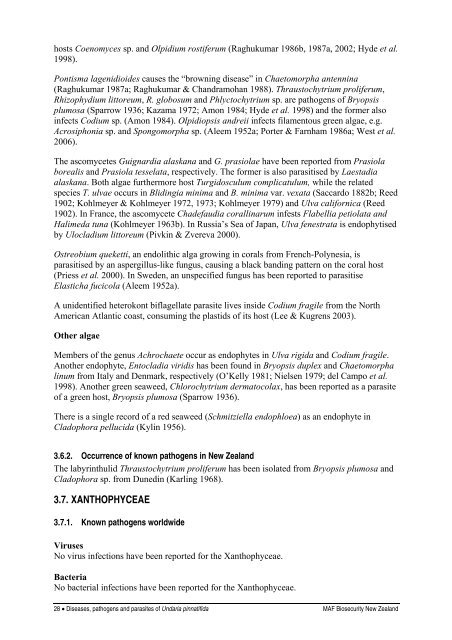Diseases, pathogens and parasites of Undaria pinnatifida
Diseases, pathogens and parasites of Undaria pinnatifida
Diseases, pathogens and parasites of Undaria pinnatifida
You also want an ePaper? Increase the reach of your titles
YUMPU automatically turns print PDFs into web optimized ePapers that Google loves.
hosts Coenomyces sp. <strong>and</strong> Olpidium rostiferum (Raghukumar 1986b, 1987a, 2002; Hyde et al.<br />
1998).<br />
Pontisma lagenidioides causes the “browning disease” in Chaetomorpha antennina<br />
(Raghukumar 1987a; Raghukumar & Ch<strong>and</strong>ramohan 1988). Thraustochytrium proliferum,<br />
Rhizophydium littoreum, R. globosum <strong>and</strong> Phlyctochytrium sp. are <strong>pathogens</strong> <strong>of</strong> Bryopsis<br />
plumosa (Sparrow 1936; Kazama 1972; Amon 1984; Hyde et al. 1998) <strong>and</strong> the former also<br />
infects Codium sp. (Amon 1984). Olpidiopsis <strong>and</strong>reii infects filamentous green algae, e.g.<br />
Acrosiphonia sp. <strong>and</strong> Spongomorpha sp. (Aleem 1952a; Porter & Farnham 1986a; West et al.<br />
2006).<br />
The ascomycetes Guignardia alaskana <strong>and</strong> G. prasiolae have been reported from Prasiola<br />
borealis <strong>and</strong> Prasiola tesselata, respectively. The former is also parasitised by Laestadia<br />
alaskana. Both algae furthermore host Turgidosculum complicatulum, while the related<br />
species T. ulvae occurs in Blidingia minima <strong>and</strong> B. minima var. vexata (Saccardo 1882b; Reed<br />
1902; Kohlmeyer & Kohlmeyer 1972, 1973; Kohlmeyer 1979) <strong>and</strong> Ulva californica (Reed<br />
1902). In France, the ascomycete Chadefaudia corallinarum infests Flabellia petiolata <strong>and</strong><br />
Halimeda tuna (Kohlmeyer 1963b). In Russia’s Sea <strong>of</strong> Japan, Ulva fenestrata is endophytised<br />
by Ulocladium littoreum (Pivkin & Zvereva 2000).<br />
Ostreobium queketti, an endolithic alga growing in corals from French-Polynesia, is<br />
parasitised by an aspergillus-like fungus, causing a black b<strong>and</strong>ing pattern on the coral host<br />
(Priess et al. 2000). In Sweden, an unspecified fungus has been reported to parasitise<br />
Elasticha fucicola (Aleem 1952a).<br />
A unidentified heterokont biflagellate parasite lives inside Codium fragile from the North<br />
American Atlantic coast, consuming the plastids <strong>of</strong> its host (Lee & Kugrens 2003).<br />
Other algae<br />
Members <strong>of</strong> the genus Achrochaete occur as endophytes in Ulva rigida <strong>and</strong> Codium fragile.<br />
Another endophyte, Entocladia viridis has been found in Bryopsis duplex <strong>and</strong> Chaetomorpha<br />
linum from Italy <strong>and</strong> Denmark, respectively (O’Kelly 1981; Nielsen 1979; del Campo et al.<br />
1998). Another green seaweed, Chlorochytrium dermatocolax, has been reported as a parasite<br />
<strong>of</strong> a green host, Bryopsis plumosa (Sparrow 1936).<br />
There is a single record <strong>of</strong> a red seaweed (Schmitziella endophloea) as an endophyte in<br />
Cladophora pellucida (Kylin 1956).<br />
3.6.2. Occurrence <strong>of</strong> known <strong>pathogens</strong> in New Zeal<strong>and</strong><br />
The labyrinthulid Thraustochytrium proliferum has been isolated from Bryopsis plumosa <strong>and</strong><br />
Cladophora sp. from Dunedin (Karling 1968).<br />
3.7. XANTHOPHYCEAE<br />
3.7.1. Known <strong>pathogens</strong> worldwide<br />
Viruses<br />
No virus infections have been reported for the Xanthophyceae.<br />
Bacteria<br />
No bacterial infections have been reported for the Xanthophyceae.<br />
28 • <strong>Diseases</strong>, <strong>pathogens</strong> <strong>and</strong> <strong>parasites</strong> <strong>of</strong> <strong>Undaria</strong> <strong>pinnatifida</strong> MAF Biosecurity New Zeal<strong>and</strong>

















